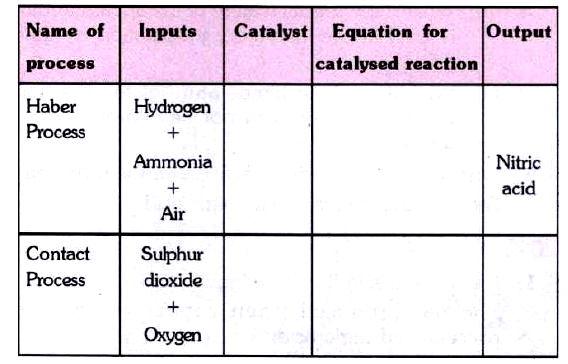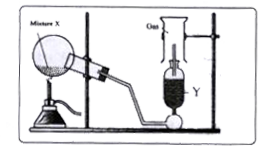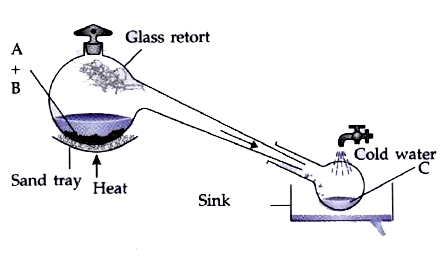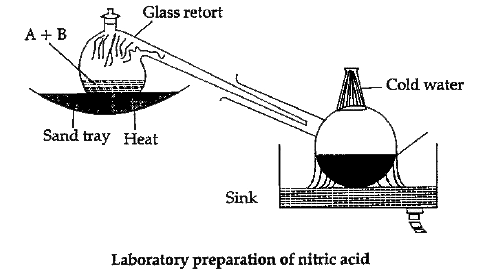Complete Solutions to SECTION-II of chapter SELF ASSESSMENT PAPER 3 of Class 10 book with complete answers and questions
| Class 10 | CHEMISTRY |
| Chapter | SELF ASSESSMENT PAPER 3 |
| OSWAL | SECTION-II |
| Number Of Questions | 40 |
| Academic Year | 2023-24 |
During the electrolysis of copper (II) sulphate solution using platinum as cathode and carbon as anode :
What do you observe at the cathode and at the anode ?
View SolutionDuring the electrolysis of copper (II) sulphate solution using platinum as cathode and carbon as anode :
What change is noticed in the electrolyte?
View SolutionDuring the electrolysis of copper (II) sulphate solution using platinum as cathode and carbon as anode :
Write the reactions at the cathode and at the anode.
View SolutionDifferentiate between electrical conductivity of copper sulphate solution and copper metal .
View SolutionAs we descend the electrochemical series containing cations, the tendency of the cations to get_______(oxidized/reduced) at the cathode increases.
View SolutionThe ________ the concentration of an ion in a solution the greateris the probability of its being discharged at its appropriate electrode .
View SolutionCopy and complete the following table relating to important industrial process. Output refers to the product of the process not the intermediate steps.

View SolutionThe metals of group-2 from top to bottom are Be, Mg, Ca, Sr, Ba. Which of these metals will form ions most readily and why?
View SolutionWhat property of an element is measured by electronegativity.
View SolutionSelect the correct method from: Simple displacement ,Decomposition by acid, Direct synthesis, Neutralization, Double decomposition used for the preparation of the given salts:
Sodium nitrate
View SolutionSelect the correct method from: Simple displacement ,Decomposition by acid, Direct synthesis, Neutralization, Double decomposition used for the preparation of the given salts:
Iron (III) chloride
View SolutionSelect the correct method from: Simple displacement ,Decomposition by acid, Direct synthesis, Neutralization, Double decomposition used for the preparation of the given salts:
Lead chloride
View SolutionSelect the correct method from: Simple displacement ,Decomposition by acid, Direct synthesis, Neutralization, Double decomposition used for the preparation of the given salts:
Zinc sulphate
View SolutionSelect the correct method from: Simple displacement ,Decomposition by acid, Direct synthesis, Neutralization, Double decomposition used for the preparation of the given salts:
Sodium hydrogen sulphate.
View SolutionThe diagram shows an experimental set up for the laboratory preparation of a pungent smelling gas. The gas is alkaline in nature.

Name the gas collected in the jar.
View SolutionThe diagram shows an experimental set up for the laboratory preparation of a pungent smelling gas. The gas is alkaline in nature.

Write the balanced equation for the above preparation.
View SolutionThe diagram shows an experimental set up for the laboratory preparation of a pungent smelling gas. The gas is alkaline in nature.

How is the gas being collected ?
View SolutionThe diagram shows an experimental set up for the laboratory preparation of a pungent smelling gas. The gas is alkaline in nature.

Name the drying agent used.
View SolutionThe diagram shows an experimental set up for the laboratory preparation of a pungent smelling gas. The gas is alkaline in nature.

How will you find that the jar is full of gas?
View SolutionA compound has the following percentage composition by mass : Carbon = 54.55%, Hydrogen = 9.09% and Oxygen = 36.26%.
Its vapour density is 44. Find the Empirical and molecular formula of the compound.
(H = 1, C = 12,0 = 16)
View SolutionThe following questions related to the extraction of aluminium by electrolysis :
Give the equation for the reaction that takes place at cathode.
View SolutionThe following questions related to the extraction of aluminium by electrolysis :
Explain why it is necessary to renew anode from time to time?
View SolutionThe following questions related to the extraction of aluminium by electrolysis :
What is the role of graphite?
View SolutionArrange the following as per the instructions given in the brackets:
Cs, Na, Li, K, Rb (increasing order of metallic character).
View SolutionArrange the following as per the instructions given in the brackets :
Mg, Cl, Na, S, Si (decreasing order of atomic size).
View SolutionArrange the following as per the instructions given in the brackets :
Na, K, Cl, S, Si (increasing order of ionization energy).
View SolutionHow does ammonium hydroxide help in distinguish between:
Iron (II) chloride and Iron (III) chloride.
View SolutionHow does ammonium hydroxide help in distinguish between:
Zinc nitrate and Lead nitrate.
View SolutionThe figure given alongside illustrates the apparatus used in the laboratory preparation B of nitric acid.

Name A (a liquid), B (a solid) and C (a liquid) (Do not give the formulae)
View SolutionWrite an equation to show how nitric acid undergoes decomposition.
View SolutionThe figure given below illustrates the apparatus used in the laboratory preparation of nitric acid.

Complete the following:
_____ is oxidised by nitric acid.
View SolutionWhen moist chlorine reacts with hydrogen sulphide, name the two products formed?
View SolutionName an organic compound used as a thermometric liquid.
View SolutionWhy is hydrogen chloride not collected over water ?
View SolutionName the chemical in which gold can be dissolved.
View SolutionName :
a yellow monoxide that dissolves in hot and concentrated caustic alkali.
View SolutionMatch the following columns

View SolutionComplete the following chemical equations :
`Al_(4)C_(3)+12H_(2)O to `
View SolutionComplete the following chemical equations :
`CaC_(2)+2H_(2)O overset(296K) to `
View SolutionComplete the following chemical equations :
`C_(2)H_(5)Br overset(KOH) underset("alc and hot")to`
View Solution
SECTION-II questions and complete solutions for chapter SELF ASSESSMENT PAPER 3 of EVERGREEN CHEMISTRY (ENGLISH) of Class 10